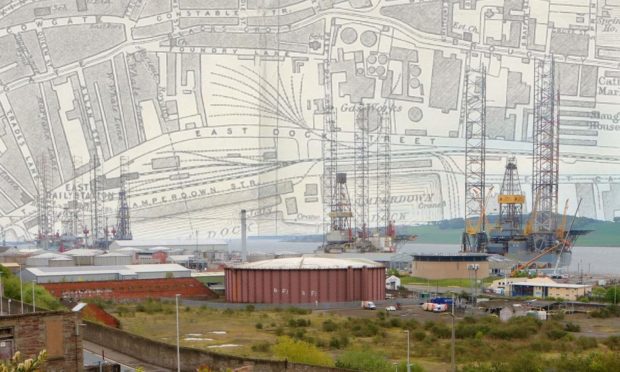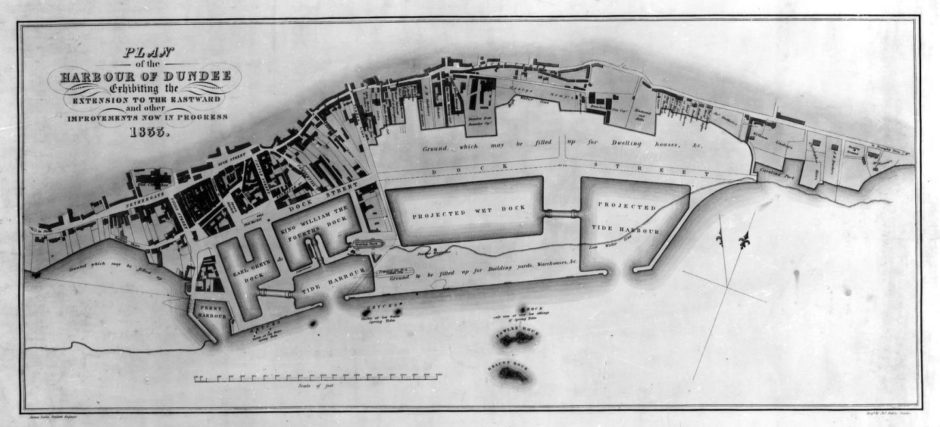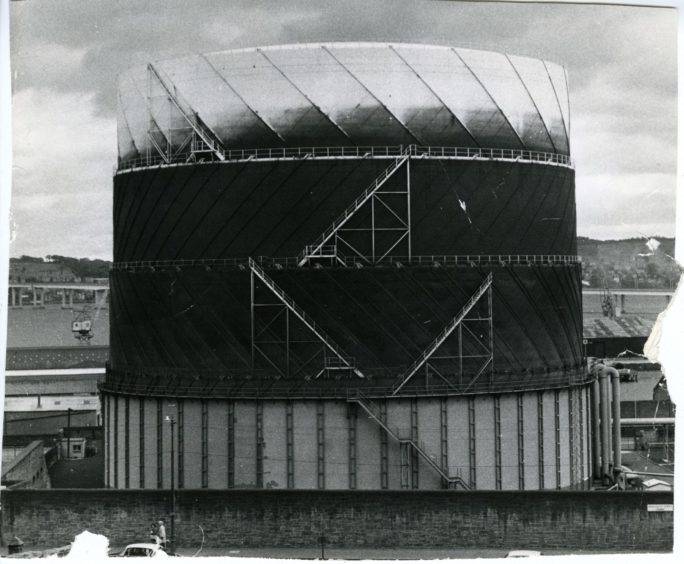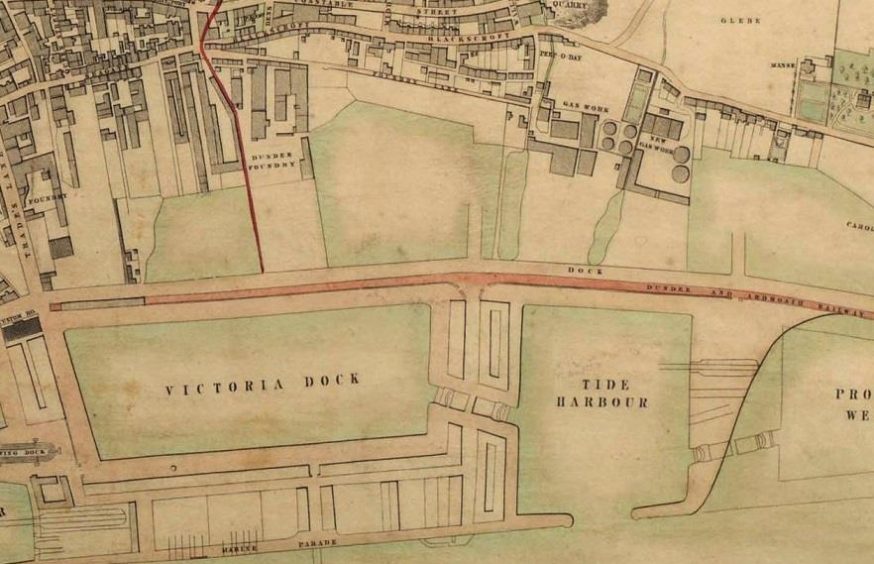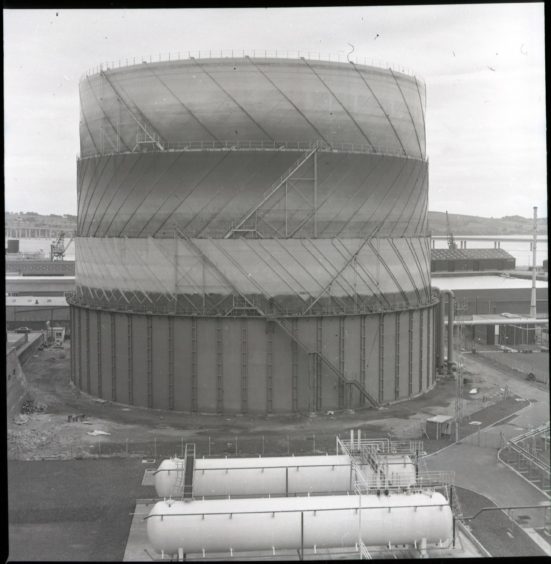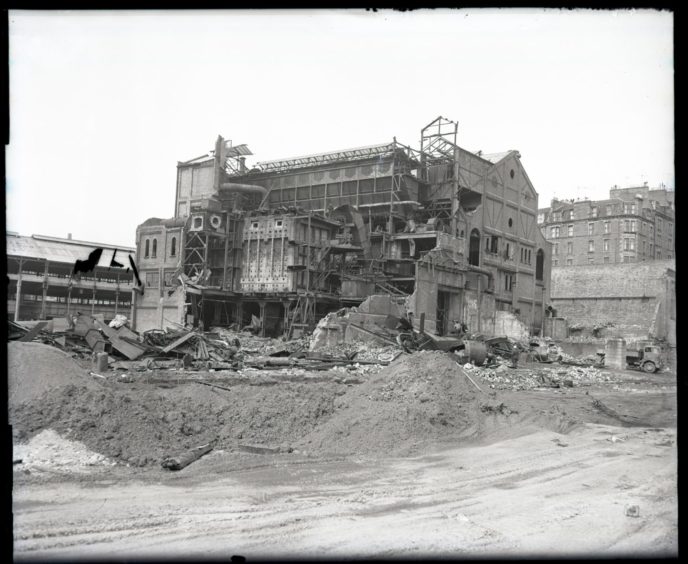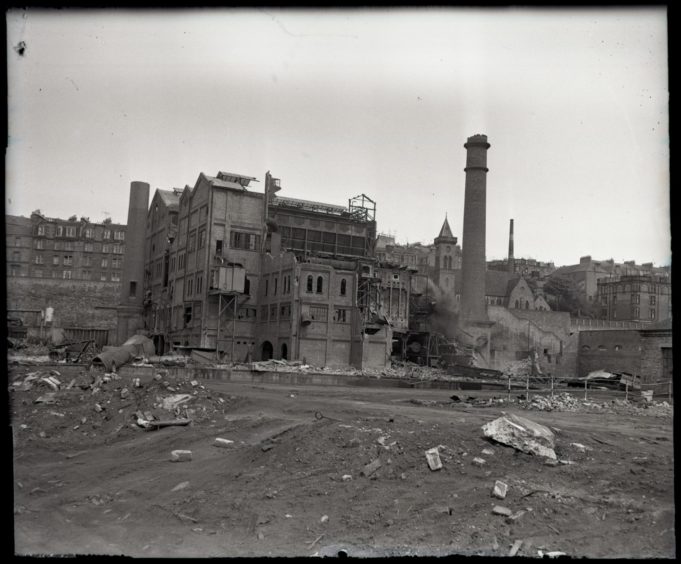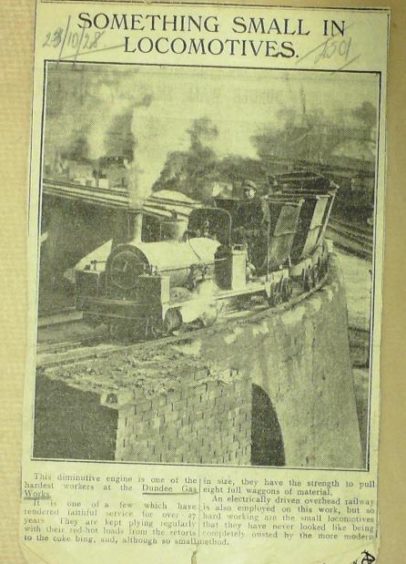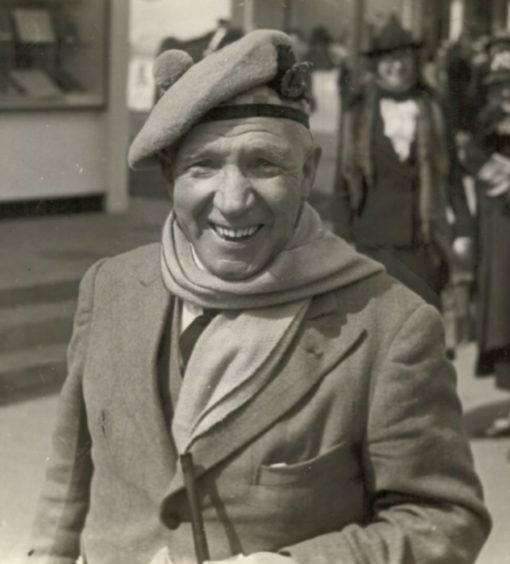A 19th Century energy war broke out between two rival gas firms that were separated by a narrow lane in Victorian Dundee.
The utility rivals eventually joined forces and would be producing 2.6 billion cubic feet of gas at the East Dock Street site, which employed more than 400 men by 1954.
Steam engines hauled loaded wagons around the gasworks where pigeons would strut among the cinders and occasionally collapse from the toxic fumes.
The discovery of natural gas reserves in the North Sea meant it was eventually uneconomical to manufacture gas and the site was demolished in 1965.
The large gasometer was kept for storage and will remain part of the landscape when the former site becomes the home Eden Project Dundee in 2024.
The arrival of gas in Dundee in 1825
In 1812 parliament granted a charter to the London & Westminster Gas Light & Coke Company, and the first gas company in the world came into being.
Less than two years later, Westminster Bridge was lit by gas.
The Dundee Gas Light Company started to lay pipes in the Seagate in 1825, before the supply was formally switched on in January 1826.
Local historian Dr Kenneth Baxter from, Dundee University, said there was a tragedy 15 years later when two people died following a huge blast.
He said: “There was a large explosion at the site on December 16 1841, with claims in newspapers of the time that it could be seen from Perth and felt from Crieff.
“There were two fatalities and damage was caused to the surrounding area.
“Houses leading to the gasworks and houses in Blackscroft had their roofs destroyed, while windows in buildings as far north as Wallacetown Church were broken.
“The door of Halley’s Mill was also damaged by the blast, although this incident is almost forgotten today despite being widely reported at the time.”
Another company, the New Dundee Gas Light Company, entered the field in 1846, which brought costs down, although some dishonest consumers were also quick to take advantage of the secrecy observed by the rival companies and obtain free light.
There was, as a consequence, an extraordinarily large amount of gas unaccounted for.
Each gas supply reportedly had its own distinctive odour, if an old fitter was to be believed, who said he distinguished between the various pipes by smelling them.
The rival firms would be taken over
Iain Flett, from the Friends of Dundee City Archives, said: “By 1850 the street directory would list that the Dundee New Gas Light Company was in operation, run by the entrepreneurial ‘writers’ (now solicitors) Shiell & Small, who were the movers and shakers in the development of local Dundee to Perth, and Dundee to Arbroath railways.
“The Ordnance Survey plan of 1858 in the National Library shows the Dundee Gas Works with its gasometers, purifiers, condensers, cooler, furnace, retort house, lime house, overlooked by the original Peep o’ Day House, with its fountain and formal gardens, with, to the east, separated by a narrow lane, the duplicate but probably more efficient works of its newer rival.
“Gas was used at this time for private and public lighting, and the Police Commissioners (who in Scotland were also responsible for public safety, sanitation, fire brigade, sewers and drainage as well as bobbies on the beat) took over the gas for the public good.”
The two companies were taken over when the Dundee Gas Act was passed in 1868, at a time when annual production was 172 million cubic feet.
In their search for cheaper and more efficient ways of public street lighting, it was the Dundee Gas Commissioners who would experiment with electricity as a possibility, and so the electricity committee started in Dundee in 1894 as a sub-committee of the gas committee.
Gas would eventually be used for heating and cooking as well, and the gasworks expanded in 1901 to take on this volume, with its own coal wagon sidings and the installation of its mini railway within that.
Small steam pug-engines were used for hauling loaded wagons of red hot coke and ashes and there was always one operating 24 hours a day.
The site was also the setting for a memorable encounter between Irish suffragette Mary Moloney and Winston Churchill during the 1908 by-election.
She appeared at Churchill’s speaking engagement to demand that he apologise for insulting remarks he had made about women and proceeded to drown him out by ringing a large bell when he refused and went off to a shed to speak to workers.
Special feature highlighted ‘sickening smell’
Mr Flett continued: “The gasworks are an interesting example of movement of public utilities from commercial investment to public ownership and then return to private investment.
“Gas stayed in the ownership of Dundee Town Council and then as Dundee Corporation up until it was nationalised in 1948, at which time Dundee City’s gasworks, gas pipes, and showroom at Commercial Street were taken into full public ownership, along with its electricity plant at Carolina Port and its wiring infrastructure.
“Until 1948, if you lived in a council house, you would pay your rates to Dundee City, your rent to Dundee City, your electricity bill to Dundee City, and your gas bill to Dundee City!”
A special feature on supplying the city with gas appeared in The Courier in 1954, which highlighted the “heavy, penetrating, somewhat sickening smell”.
A special correspondent from The Courier said: “Walk through the East Dock Street entrance into a yard surrounded by dark and morose erections, bleak and dispirited walls, odd and uninspiring tanks and chimneys, and you say: ‘Here is a place dedicated to the task of making the home brighter and warmer and happier, which must itself be one of the least attractive spots in the district’.
“It is rather like the story of the lion’s carcase and the honey.
“The pigeons do not seem to mind.
“Absurd birds, they make their way in through the door and the roof, and strut haughtily around among the cinders.
“The gasworks is a great howff for companionable pigeons.
“Sometimes the atmosphere becomes too much for them, and occasionally an unobservant pigeon, overcome by the odour, falls to the ground insensible, whereupon it is removed to the open air.
“Revived by the breeze, the pigeon rushes enthusiastically into the gasworks again.”
The demise of the gasworks
After the discovery of natural gas in the Viking Field in 1965, coal gas would be replaced by natural gas piped in from the North Sea, and all the old machinery would become redundant, along with the smell of sulphur and coke that hung over the gasworks, but storage would still be required so some gasometers were kept.
Mr Flett said: “Many readers will remember the last of the gas lamps in Dundee, and some can now be seen in the stunning black and white photographs of Joseph Mackenzie on show in The McManus, as well as remembering the ‘leeries’ which were immortalised in the poem by Robert Louis Stevenson, who would light and close down the lamps at dusk and dawn.
“I remember speaking to a ‘leerie’ in the 1970s who recalled that the gas lamps at Riverside Drive were hard to light in a gale when you were hanging by one arm to a ladder and the other was fishing for a pocketful of Bluebell matches…
“Memorably, the late Henny King, colourful organiser of Dundee 800, would persuade Scottish Gas to paint the large gasometer as a giant birthday cake.”
What happened to the trains from the gasworks?
The late Ian Fraser, from Arbroath, acquired a pug from Dundee Gas Works in 1959, which was one of two being disposed of by the Scottish Gas Board.
There had been four locomotives in use, numbered 14-17.
Locomotives 14 and 15 were saved with 14 going to a museum in Wales and 15 heading to Mr Fraser, who had applied for planning permission to build an engine shed at his new house in Arbroath, which he was describing as his “palace of engineering”.
Dr Kenneth Baxter, from Dundee University, said the Arbroath Guide from October 31 1959 reported that he named the engine Bonnie Dundee.
Dr Baxter said: “It was said to have been built about 60 years earlier by Kerr-Stuart of Stoke-on-Trent.
“The same report states that it was one of two being disposed of by the Scottish Gas Board with the other going to the museum collection at Talyllyn Railway.
“The report says the two little engines were the sole survivors of their type and had worked day in, day out.
“Apparently, Sir Harry Lauder came specially to see them ‘and was not content until he had a trip on the footplate!’.
“The Caledon shipyard had apparently taken the engine for preliminary heavy work before it would go to Arbroath, as this was beyond the facilities Fraser had at his home.”
Arbroath connection lives on
Bonnie Dundee was donated to the Ravenglass & Eskdale Railway in 1976.
After a regauge and rebuild, it emerged as an 0-4-2T in 1982, with the side tanks from former R&ER locomotive ‘Ella’, and was used on winter and other lighter trains.
Bonnie Dundee was rebuilt again in 1996 and she is now on long-term loan to Cleethorpes Coast Light Railway, which is operated by Matthew Kerr from Arbroath.
Mr Baxter said it would be nice if Eden Project Dundee could reflect the old railway links in the new development.
Dundee Eden Project: Stunning drone footage shows bird’s-eye view of gasworks site
